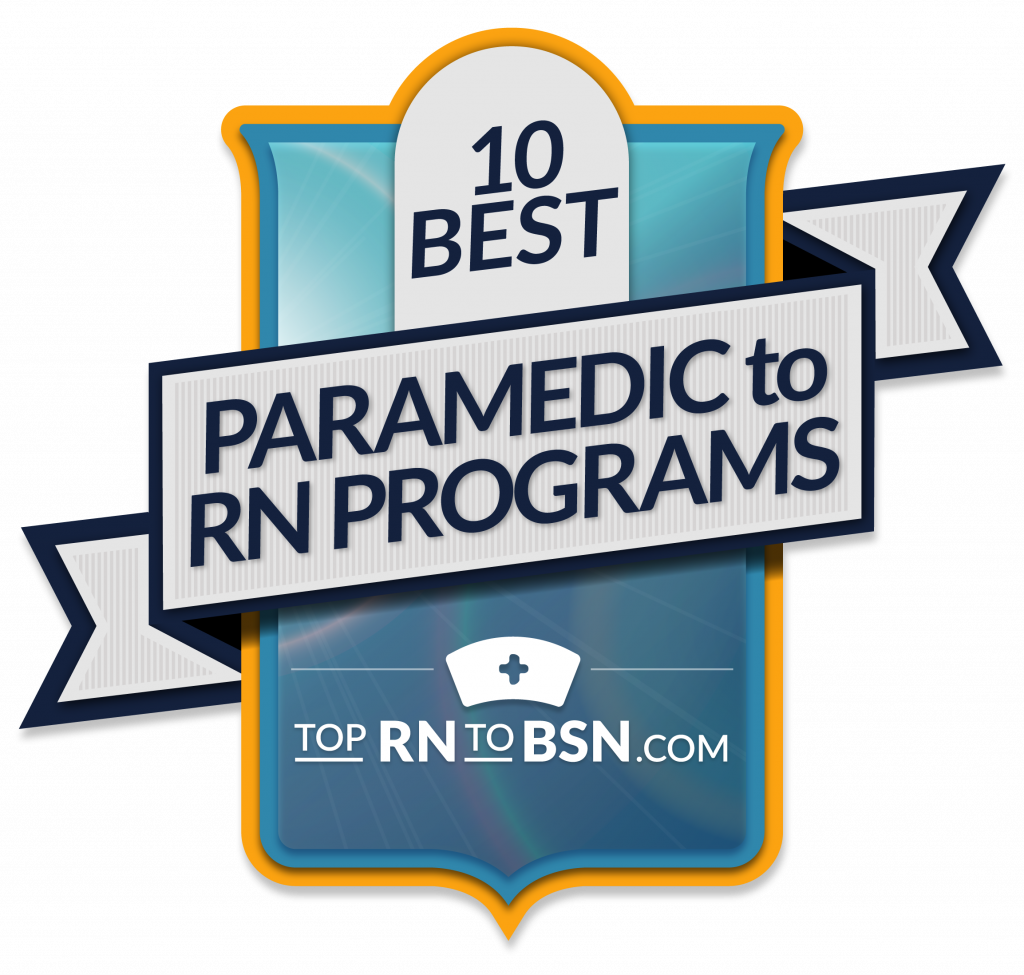
Paramedic to RN Bridge Programs
The best Paramedic to RN bridge program online offers emergency medical workers flexible education and work credit for a quick path to an RN. Paramedics who keep up with their training have many classes they need to cross over the bridge into a reputable RN program. Enrolling in a Paramedic-to-RN-bridge program will fill in any gaps that may have been missing. Paramedics train to work under less-than-ideal situations and understand the need for accurate documentation. For a paramedic to continue to move forward, the next natural step is to transition over the bridge to become a full RN.
Individuals who have been paramedics for several years may not have many options for advancement if they choose to remain in that career field. However, paramedics can advance into nursing or become instructors by crossing the RN bridge. Once the paramedic decides to cross the RN bridge, they can begin to apply for positions that will allow them to utilize their new skills. Additionally, paramedics experience working in a more structured environment as nursing students.
How We Ranked the Best Paramedic to RN Bridge Program Online
TopRNtoBSN editors want to see healthcare professionals make the most of their educational and career opportunities, so ranking the best online Paramedic-to-RN-bridge programs features accredited, reputable institutions. Programs rank according to their cost, student success, and reputation.
1. Albany State University

Albany State University (ASU) offers an accelerated coursework curriculum for a healthcare professional to RN degree program. This program is for those with a Licensed Practical Nurse or a paramedic certification and at least twelve months of professional experience. ASU’s program offers rolling enrollment, starting classes every five semesters for degree candidates interested in earning their Associate Degree in Nursing. Additionally, the university’s hybrid program offers courses on campus and online. Clinical work is done in the school’s lab or Phoebe Putney Memorial Hospital.
The university first opened in 1903. Combined with Dalton State College, the university is now a member school of the University of Georgia system. The school’s urban campuses in Albany & Cordele are home to more than 6,100 students. Albany State University is considered an HBCU – a historically black university.
Degree: ASN
Format: Hybrid
More: Visit the program
Best HBCU for Nursing Colleges and Schools
2. Community College of Baltimore County

The Community College of Baltimore County’s (CCBC) School of Health Professions offers an Associate of Science (AS) in Nursing and has received accreditation from the ACEN – the Accreditation Commission for Education in Nursing. The CCBC online Paramedic-to-RN bridge program requires the completion of 70 credit units to graduate. Prerequisite coursework for the health professional to RN degree program includes general education classes and Biology, Human Anatomy, Psychology, and Microbiology. In addition, program coursework includes Nursing Concepts 1 & 2, Pediatric Nursing Concepts, Maternal and Newborn Nursing Principles, and LPN to RN transition.
The Community College of Baltimore County opened in 1957. The college operates three campuses in Dundalk, Essex, and Catonsville. In addition, the school has three other satellite facilities and serves approximately 70,000 students. Additionally, CCBC is recognized as a National Alternative Fuels Training Center (NAFTC).
Degree: ASN
Format: Hybrid
More: Visit the program
Best Nursing Schools in Baltimore
3. Howard Community College

Howard Community College’s (HCC) Nursing Department offers an Associate of Arts (AA) degree program in Nursing designed explicitly for paramedics with a Maryland paramedics license. In addition, students enrolled in this online paramedic-to-RN bridge program provide students with a transition course to join the regular program in their second year of studies. HCC offers several AA nursing degree options, including an accelerated track, a pre-allied health track, and a military to RN pathway track.
HCC was established in 1966. The school operates a main campus in Columbia and two satellite centers. Its campus covers 100+ acres and serves nearly 30,000 studying for the more than 100 programs the school offers.
Degree: AA
Format: Online
More: Visit the program
4. Pueblo Community College

Pueblo Community College (PCC) offers a paramedic to RN degree program that fast-tracks paramedics to an RN program. The college’s Associate of Applied Science (AAS) has ACEN accreditation. Additionally, students can complete the Pueblo RN program in 3 semesters, and it is the first type of program in the state of Colorado. Coursework prepares students to sit for the CNCLEX exam and covers topics in obstetrics, gerontology, pediatrics, and psychiatric health, to name a few.
PCC was established as the Southern Colorado Junior College in 1933 as the SCJC. The school operates several Pueblo campus campuses that serve more than 5,400 students. In addition, the college administers the Early College Program, which provides college-level courses to high school students for minimal cost to the student.
Degree: ASN
Format: Hybrid
More: Visit the program
5. St. Johns River State College

St. Johns River State College (SJRSC) offers an Associate in Science degree program in Nursing that can be completed on-campus and online. This Paramedic-to-RN-bridge program from St. Johns River State College gives degree candidates a jump start on their nursing degree requirements. It prepares them to sit for the NCLEX-RN exam (National Council on Licensure Examination for Registered Nurses). In addition, St. Johns River State College’s LPN to RN, ADN program has received accreditation from the ACEN.
St Johns River State College began in 1958. The school is a member school of the Florida College System with Orange Park, St. Augustine, and Palatka campuses. In addition, the college is the parent school of the Florida School of the Arts. SJRSC serves more than 10,400 students. The first classes for the St Johns River State College were in a church.
Degree: ADN
Format: Hybrid
More: Visit the program
6. Mesa Community College

Mesa Community College (MCC) offers a Paramedic to RN (AAS – Associate degree in Applied Science) degree program that can be completed through the school’s hybrid format. Graduates from the best online Paramedic-to-RN-bridge program from Mesa Community College are eligible for advanced placement in the AAS nursing program. In addition, degree candidates are eligible to sit for the NCLEX-RN exam for licensure. Mesa Community College’s paramedic to RN degree program requires the completion of 10 credit units before entering the AAS in Nursing degree program.
MCC opened in 1965 and is the largest community school in Maricopa County, AZ. MCC’s urban campuses in Mesa, plus the satellite locations, are home to nearly 26,000 students studying more than 200 degrees offered by the school. The college began as an extension facility for Phoenix College several years before MCC opened.
Degree: AAS
Format: Hybrid
More: Visit the program
7. Hutchinson Community College

Hutchinson Community College (HutchCC) offers an Associate of Science degree in Nursing (ADN) that prepares degree candidates to sit for the RN licensing exam (NCLEX–RN). Students must also pass technical standards for admission to the program regarding hearing, vision, fine motor skills, and tactile abilities. In addition, degree applicants must complete the Kaplan Admission test before application.
Hutchinson Community College started in 1928 as the Hutchinson Junior College. HutchCC’s campus serves more than 13,000 students studying for more than 65 programs at the associate’s level, including more than 45 technical programs. In addition, Hutchinson Community College operates two satellite facilities in Newton and McPherson, KS.
Degree: ASN
Format: Online with required travel to Kansas to complete the clinical portion of the program
More: Visit the program
8. Pellissippi State Community College
Pellissippi State Community College (PSCC) offers a one-year LPN/Paramedic to RN program (AAS degree). Lectures are asynchronous online. Labs, Exams, and Clinicals are in person with flexible scheduling. Pellissippi’s hybrid Paramedic-to-RN-bridge program prepares students to sit for the national nursing license exam, the NCLEX-RN. Coursework for Pellissippi State’s healthcare profession to RN degree program includes Statistics, Microbiology, Medical-Surgical Nursing, Mental Health Nursing, Pediatric Nursing, plus Women’s Health, to name a few.
PSCC opened in 1974 as the State Technical Institute at Knoxville. Pellissippi State consists of five satellite campuses in the two-county area of Knox and Blount Counties. The original campus of the college was an academic extension of the vocational school known as Knoxville State Regional. The state’s Board of Regents governs Pellissippi State.
Degree: AAS
Format: Hybrid
More: Visit the program
9. San Jacinto College
SJC offers a hybrid Associate of Applied Science degree in Nursing (AASN). The program is for healthcare professionals with a valid and unencumbered paramedic license or License Vocational Nurse (LVN) license. The SJC paramedic-to-RN program has accreditation from the Accreditation Council for Education in Nursing (ACEN) and the Texas Board of Nursing (BON). In addition, San Jacinto graduates boast a 90% first-time pass rate for the NCLEX–RN exam.
The college started in 1961 to serve the Houston metro area. Today, the school specializes in emergency medical technology education and maritime trade programs. In addition, the college serves more than 29,000 students across the three campuses and six satellite centers. SJC operates nine academic facilities, three of which are considered branch campuses.
Degree: AAS
Format: Hybrid
More: Visit the program
Best Nursing Schools in Austin Texas
10. Herzing University
Herzing offers a Paramedic to Bachelor of Science in Nursing (BSN) degree program that students can complete online. The university’s paramedic-to-RN bridge program has accreditation from the CCNE. Additionally, degree candidates can transfer college credits, up to 90 eligible credits. Students typically complete Herzing University’s paramedic to BSN degree program in approximately 30 months. Herzing University’s BSN program graduates are eligible to sit for the national RN licensing exam, NCLEX.
Herzing opened in 1965 as the Herzing Institute, a private institution of higher learning. The school’s campuses are in Ohio, Georgia, Alabama, Wisconsin (several locations), Louisiana, and Minnesota. This university was initially a computer training school in downtown Milwaukee but has grown to nine campuses nationwide.
Degree: BSN
Format: Online
More: Visit the program
What are a Paramedic to RN Bridge Programs?
Licensed paramedics can enroll in a bridge option to earn an ADN degree and become registered nurses. Daily paramedic experience includes emergency care and critical care, so they are familiar with part of a nurse’s job. These accelerated-pace programs are for paramedics who have current licensure and want to advance their careers.
Paramedic to RN Bridge programs helps paramedics transition into registered nursing by providing an accelerated path to an Associate’s or Bachelor’s degree in Nursing. The program typically requires fewer prerequisites than a traditional nursing program and provides credit for the paramedic’s existing education and work experience. Many Paramedic to RN programs also provides additional clinical training and mentorship opportunities to ensure that paramedics are prepared to enter the nursing profession.
What are the Admission Requirements for a Paramedic Bridge Program?
The admission requirements for a Paramedic to RN Program will vary depending on the school and program you are considering. Generally, applicants must meet the below requirements.
- possess an unencumbered Paramedic certification
- a high school diploma or equivalent
- pass an entrance exam such as the Test of Essential Academic Skills (TEAS)
- submit immunization records, official transcripts, and a resume
- complete nurse aide training
- many programs require a minimum number of hours of clinical experience
Why Attend a Paramedic to RN Bridge Program?
Some individuals want to build on their paramedic training and experience to pursue a degree as a registered nurse. A Paramedic-to-RN-bridge Program is an educational program designed to help paramedics transition into the field of registered nursing. The program typically combines online, classroom, and clinical education, allowing paramedics to earn an associate’s or bachelor’s degree in nursing. Previous paramedic coursework is typically accepted for transfer credit. So paramedics can transition into nursing quickly and easily.
Long-term stability is another reason many paramedics choose to pursue an RN degree. The fast-paced, high-stress environment can be hard to maintain as you age. Transitioning from a paramedic to an RN over the bridge will lead to a more stable work environment. An RN’s job requires fast thinking and coping with stress. However, nurses train to work in a structured and stable environment.
Can You Get a Paramedic to RN Degree Online?
Many Paramedics to RN bridge programs offer at least a portion of the coursework online. Classes with no hands-on activities are easy for students to complete online. Taking part in the Paramedic-to-RN-bridge program accomplishes several goals. First and foremost, it gives the paramedic additional knowledge to offer more advanced, higher-quality care to the patients they see in the field.
Benefits of an Online Program
Online Paramedic-to-RN-bridge program classes allow students to stay on the job. Completing as much of the bridge program online as possible allows paramedics to continue to work while they attend school. This will enable them to keep their skills sharp and begin practicing new techniques while working in the field. In addition, continuing to serve their communities means that more lives will be saved when they start taking online classes.
Online classes allow for a gradual transition from a paramedic to an RN. Taking classes online will enable students to study when convenient for them. They can look at their own pace, which allows them to retain better the information they learn in their online courses. With online learning, the student can learn when and where it is most comfortable for them as an individual. Every person is different when it comes to how they can learn. For those who like structure, a classroom setting may be most beneficial. In contrast, students who are easily distracted may prefer a different format.
What to Look For in a Paramedic-to-RN Program
Accreditation
Make sure the program is accredited by a reputable accrediting body. It should be either regionally or nationally accredited, and the school should be able to provide proof of its accreditation.
Why is Accreditation Important for a Paramedic-to-RN Program? Accreditation ensures that a program meets the high standards set by the Commission on Collegiate Nursing Education (CCNE) or the Accreditation Commission for Education in Nursing (ACEN). It also ensures that students receive a quality education that meets the educational and professional standards of a registered nurse.
Additionally, accreditation ensures that students can take advantage of financial aid opportunities, such as grants and loans, which can help students pay for the program. After graduation, employers will recognize the program, which is essential for job placement.
Program Length
Look for a program that offers an accelerated option for those with an existing paramedic background. This can help speed up the time it takes to complete the program and become a registered nurse.
How long is a Paramedic to RN program? Eighteen to 24 months is the approximate length of time it takes most students to go from a paramedic to an RN by enrolling in a bridge program. This can vary from student to student for several reasons. To maintain their certification, paramedics must take continuing education courses. Some of the courses can count toward the CE requirement. Over the years, this can directly impact the time it takes for a paramedic to become a fully licensed RN.
Curriculum
Find a program that offers a comprehensive curriculum to ensure you get the best education possible. Make sure the program includes courses such as anatomy, physiology, pharmacology, and medical-surgical nursing.
What Do You Learn in a Paramedic to RN Program? A Paramedic to RN Program allows students to become Registered Nurses. Students learn the fundamentals of nursing, including anatomy and physiology, pharmacology, clinical assessment and diagnosis, health promotion and disease prevention, and professional nursing practice.
In addition, students will gain practical experience in the clinical setting to prepare them for the job. The program also focuses on leadership, management, and communication skills to ensure graduates are ready to work in various healthcare settings.
Nursing Courses:
- health assessment
- fundamental chemistry
- microbiology
- nutrition
- anatomy and physiology II
- nursing theory
- pathophysiology
- advanced pharmacology
- nursing research
- mental health nursing
- community health nursing
- patient care planning
Cost
Be sure to compare the cost of tuition and other associated fees between programs to ensure you get the best deal. If you need federal financial aid, make sure you apply early using the FAFSA. also apply for nursing scholarships as early as possible.
Clinical Experience
Look for a program that offers a variety of clinical experiences in a variety of settings, so you can gain the experience you need to become a successful nurse.
Program Format
Online vs a More Traditional Path. For some students, transitioning from a paramedic to an RN is not an immediate goal. Instead, paramedic students begin their classes whenever they choose and gradually work through online courses. Then, they reach a point where they must perform clinical or other hands-on activities. Completing the paramedic to RN program can take as long as five years in cases like this.
Students who choose to take a more traditional path can work as a paramedic and begin to take their RN bridge program courses according to schedule. If they take accelerated courses, they can complete their class schedule in as little as 18 months and begin to prepare for their licensing exam. If the student sticks to the class schedule provided, it will take them approximately 24 months to complete their degree and take their licensing exam. It’s up to the student how quickly they want to pursue their degree. Some will have strict timelines, while others enjoy their work and gradually move forward.
Support Services
Look for a program that offers support services to help you succeed, such as tutoring, counseling, and career services.
Job Outlook for Paramedics Becoming RNs
The outlook for paramedics becoming RNs is very positive. The demand for RNs is projected to grow much faster than the average for all occupations through 2031, with an estimated growth rate of 6%. This is due to an increasing number of aging baby boomers and an increasing emphasis on preventative care. As a result, there will be plenty of opportunities for paramedics who decide to pursue a career as an RN.
Paramedic to RN Salary Comparison
The salary of an RN is typically much higher than a paramedic. On average, a registered nurse earns an average annual salary of about $73,000, while a paramedic earns an average of $45,000. The difference in salary between a paramedic and a registered nurse can range from $20,000 to $50,000 or more. However, salaries vary by location, experience, and specialty.
| Salary | Paramedic / EMT | RN |
|---|---|---|
| Median Pay | $36,930 (BLS) | $77,600 (BLS) |
| Range | $23,620 to $47,580 | $59,450 to $120,250 |
Related Rankings:
- Unique Nursing Certifications
- Best Paying Nursing Fields for the Future
- 10 Best Nursing Schools in Houston
- Most Affordable Nursing Schools in NYC
- Alternative Nursing Careers
- 15 Best Online RN to BSN Programs in MA
- Most Affordable Online RN to BSN Programs
- 10 Best Nursing Schools in San Diego
- 10 Top Nursing Schools in Raleigh NC






